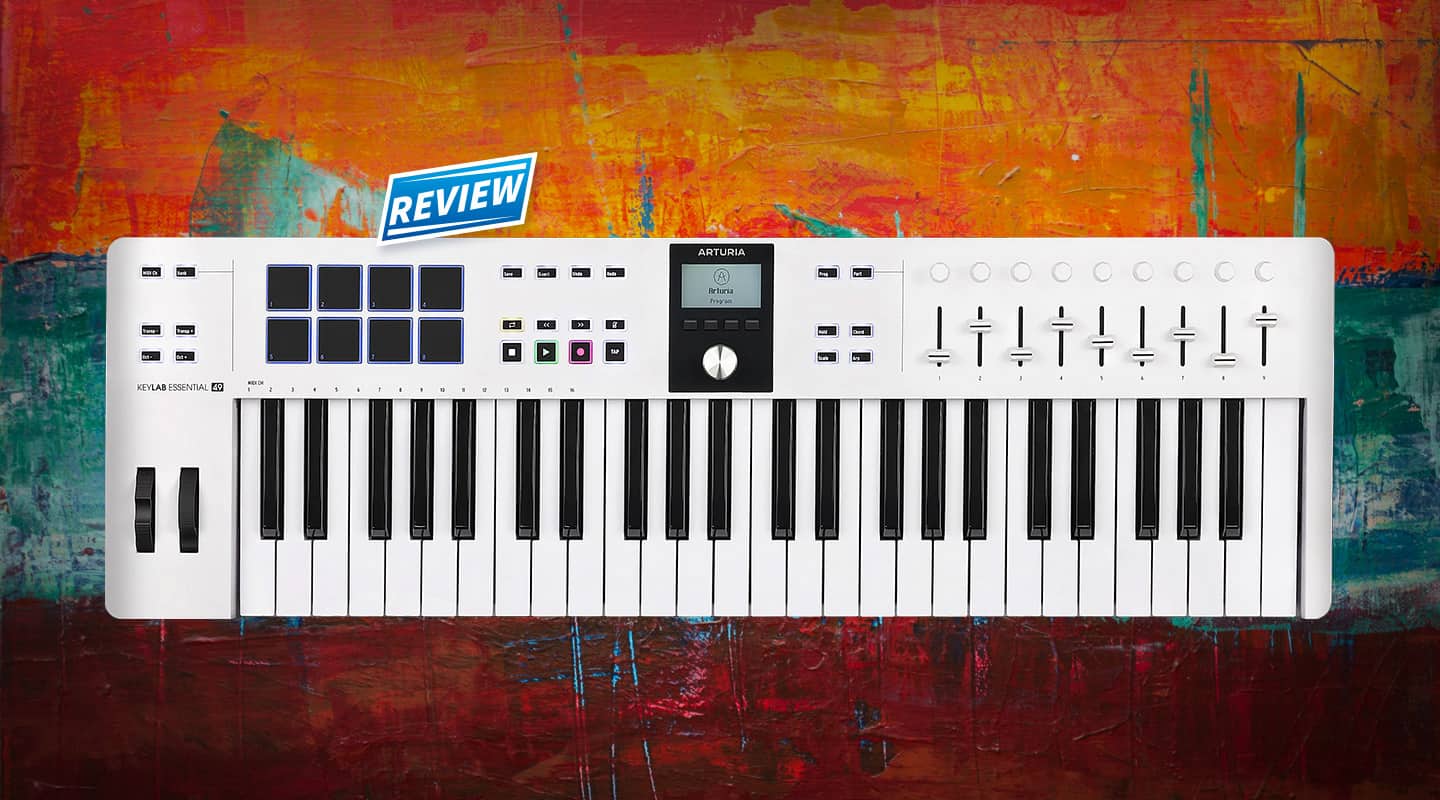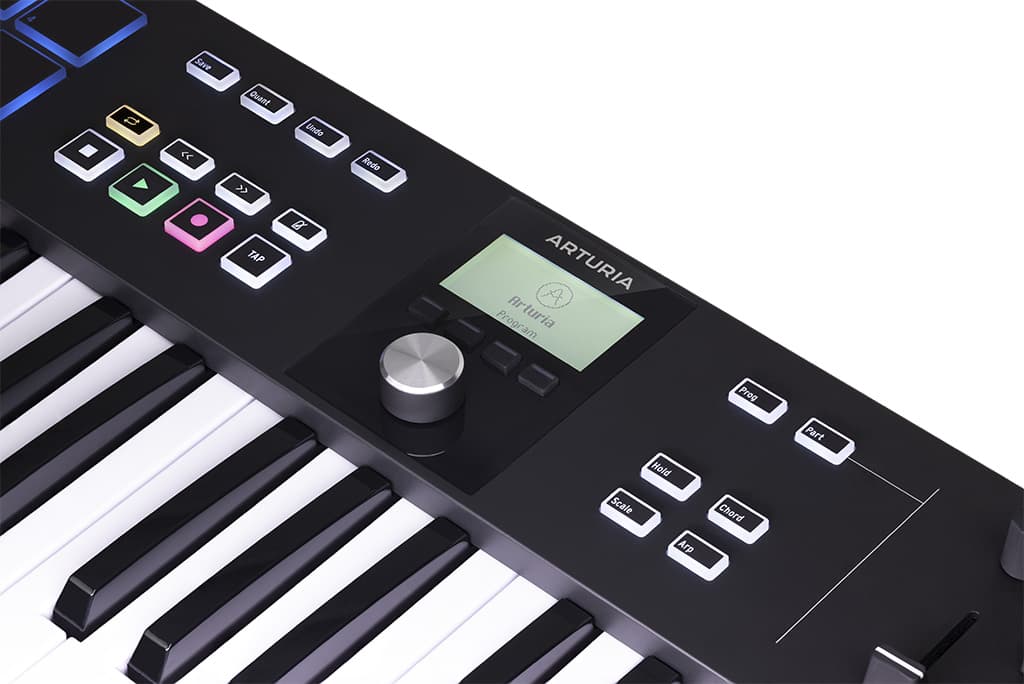
Review: Arturia Keylab Essential Mk3
A new take on Arturia’s lightweight controller with deep DAW integration and creative tools.
What are the key factors behind your choice of a controller keyboard? Good question. I’m glad you asked, because it’s something I’ve been giving some thought to while testing the new Keylab Essential Mk3 — Arturia’s latest lightweight controller.
Firstly, will you be mainly using it in the studio or on stage? If it’s a performance keyboard then you’re likely to want the best keybed you can afford (probably weighted if you’re a piano player) and enough pots and sliders to deal with whatever sound source you use. For example, many who use Mainstage will use an eight-slider controller for pushing up the right sound at the appropriate time (Korg’s NanoKontrol seems to be the unit du jour).
If, on the other hand, you’re not worried about live performance, then an expensive keybed isn’t such a big deal. In fact, a lighter touch that’s just as good for belting out lead lines, chords or drum parts, is more useful. You probably also want your controller to help you audition sounds, quickly mess with presets, and make sonic decisions quicker and easier than with a keyboard and mouse. What’s more, some DAW integration would be handy — transport control, at the very least.
Let’s take a look at Arturia’s Mk3 of Keylab Essential and see if it’s for you.
MIDI & HUI
For starters, let’s acknowledge the obvious. All keyboard controllers have more in common than they do differences. They all spit out MIDI data to control (in most cases) your computer running a DAW or soft synth (MIDI is a 40-ish year-old invention). Just about everyone uses the HUI language for other control messages (something Mackie invented 20-plus years ago). So the truth is, if you had all the time in the world, you could program just about any controller keyboard on the market to perfectly fit your workflow. In fact, in the early days of controller keyboards, that’s kinda what we were expected to do… most of those people are now bald.
In other words, no one has that sort of patience, not even during covid. So we quite reasonably expect the manufacturer to do the hard work for us and map all those pesky MIDI controller messages so we don’t have to.
Which is why we see platform-focussed controller keyboards. For example, if you spend most of your time in a Native Instruments sonic environment, you’d be mad not to look at the NI Komplete Kontrol. Push is obviously an Ableton controller with deep Live integration. Novation has released FLkey for the ‘fruity’ crew… and guess what, Arturia’s Keylab ranges are awesome if you rely on Analog Lab and its V Collection of instruments.
NEED TO KNOW

STRAIGHT TO THE LAB
This is my experience. I often use Analog Lab when playing live and V Collection accounts for at least half of my synth sounds when I’m in the studio. So Keylab Essential should really be up my alley.
I eagerly connected it to my laptop using the supplied USB cable, fully expecting every Analog Lab virtual fader and pot to be automatically mapped to the controller, and feeling just a bit miffed when they weren’t!
Rookie error. I discovered I’d not updated Analog Lab in a year. After that download and a restart, Keylab Essential and Analog Lab instantly shook hands, with everything nicely mapped.
The nine pots and nine faders of the controller match the pots and faders in the Controls section of Analog Lab. The top row of pots offer broadbrush control of the tone and the effects levels. The parameters allocated to the row of faders depend on the synth engine. The DX7 synth, for example, will have Operator levels and Algorithm adjustments; the Piano instrument has a bunch of keyboard-relevant adjustments to make; while Prophet VS has joystick adjustments and Wave Osc levels… you get the idea.
Being able to audition presets and mess with them without recourse to your computer or a mouse is a big deal. You are guaranteed to go places you wouldn’t normally go if you’re forced to mouse-click and adjust every time.
If you own any or all of the V Collection instruments then Keylab Essential will, of course, happily converse with those. You don’t have the neat array of corresponding nine pots and sliders but Keylab’s controls dive into the most useful parameters of that instrument. I found it best to use the expanded Editor view of the virtual synths to get a better understanding of what I was messing with.
Using Keylab’s big, central encoder to scroll through the presets is another luxury. You can use the display to get an at-a-glance view of your favourite sounds (with the Heart icon) and riffle the deck using Genre and Categories.
The touch-sensitive pads might be expected but they’re also very valuable for bashing out drum parts and/or triggering samples.
To me, all this is a ‘shut up and take my money’ moment. I was already having more fun and digging deeper for more individualised sounds.
ARP’ING ON
But wait, there’s more. Mk3 has an improved Arp section. Press and hold the Arp button to access a number of customisable parameters. Similar deal with the Chord function. Press and hold to select your one-finger chord or build your own. Similarly, the Scale function will switch up your keyboard to only play notes in the selected scale, allowing you to play like Rick Wakeman without even trying. These are handy, creative features.
Keylab Essential, is a well-priced match for your Arturia sound sources and a worthy partner for your DAW of choice.

DISPLAY
The Mk3 display is larger and more informative than before and has four ‘contextual’ keys. For starters, you’ll want to use it to select the Program mode. Performance mode describes what we were doing with Analog Lab and V Collection. The DAW mode is an interesting and powerful feature that opens up deeper integration with five of the top production DAWs on the market: Live, Logic Pro, FL Studio, Cubase, and Bitwig. I’d heartily recommend you investigate how Keylab Essential integrates with your particular DAW, as there are too many differences platform-to-platform to list here. But I can assure you there’s a lot more on offer than transport control.
Unfortunately, my DAW of choice, Reason, isn’t supported… probably because most pundits are seeing Reason more as a VST plug-in these days, unfortunately.
BUNDLE
If you’re coming in cold, without any DAW or virtual instrument baggage, then Keylab Essential ships with a nifty bundle of goodies that will get you making music in no time, including Analog Lab V, Ableton Live Lite, a two-month subscription to Loopcloud, and a couple of superior piano instruments.
CONSUMER CHOICE
If you rely on Arturia sounds and perform live, then the more expensive Keylab Mk2 range is worthy of your consideration. Keylab Essential will, of course, perform just fine on stage but its very lightweight and more likely be your second controller rather than a master.
In the studio, Keylab Essential, is a well-priced match for your Arturia sound sources and a worthy partner for your DAW of choice.
If you’re currently putting up with a generic MIDI keyboard then you’ll be amazed how much more fun you’ll have working with Arturia’s sounds using Keylab Essential. The ability to scroll through sounds, mess with sounds, then create more interesting performances using the Chord, Arp and Scale functions, all without recourse to your mouse or keyboard, is an eye-opener, and an experience I’d heartily recommend.



























RESPONSES